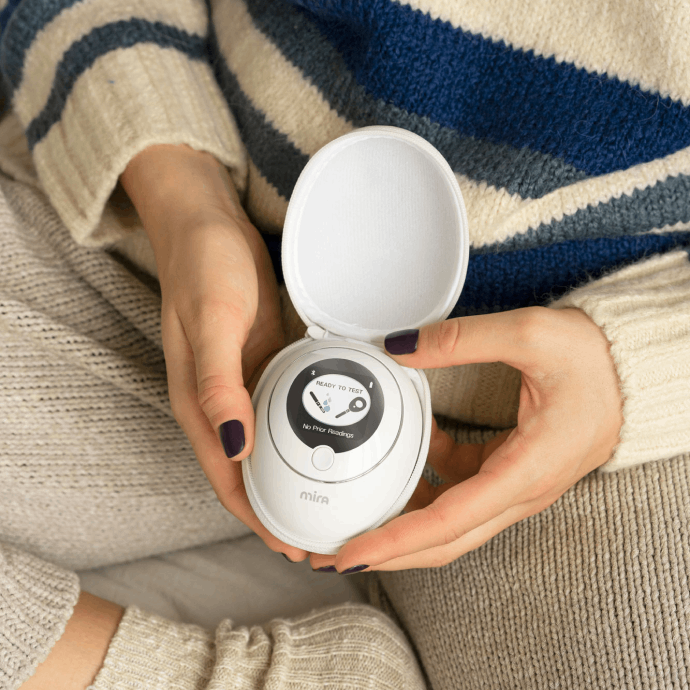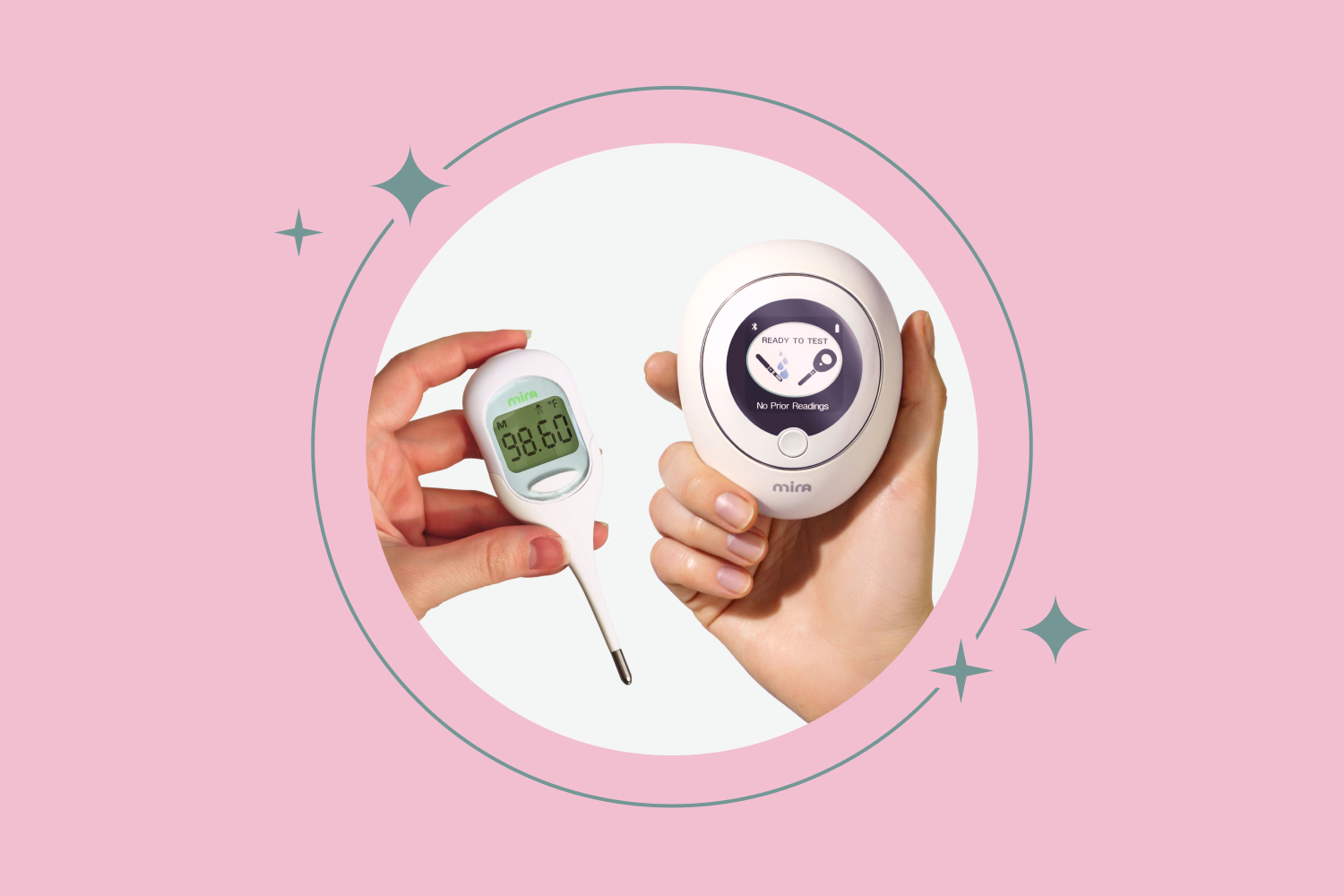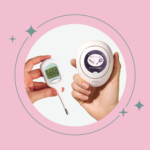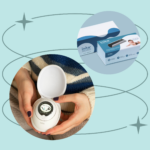Mira vs Kegg: what’s the most reliable fertility tracker?

If you are actively planning a pregnancy, you’re probably already familiar with the many different ways you can track ovulation and fertility.
At Mira, our Monitor and Wands can measure fertility hormone levels in urine to help pinpoint ovulation. Other common fertility tracking devices include ovulation predictor kits (OPKs), basal body temperature (BBT) thermometers, and one device – known as kegg – which analyzes cervical mucus.
In this article, we’ll take a closer look at kegg specifically, to see how Mira stacks up against it in terms of accuracy and reliability.
Ready? Let’s go!
About Mira
Mira is an AI-powered fertility monitor that can measure and track key fertility hormones in urine. Over 100,000 people have used the Mira App and Monitor, and Mira was named by Fast Company as one of the most innovative companies of 2024.
Currently, Mira can test the following hormones: Luteinizing Hormone (LH), Estrone-3-Glucuronide (E3G), Pregnanediol-3-Glucuronide (PdG), and Follicle Stimulating Hormone (FSH). Soon, it will also be able to test for human chorionic gonadotropin (hCG).
In terms of technology, Mira uses immunochromatography with fluorescence labeling. This allows the device to measure exact, numeric hormone levels in urine. Together with Mira’s powerful AI, individuals can predict their fertile window with up to 99%* accuracy.

In an effort to help close the research gap in women’s health, Mira also collaborates with universities across the world – such as Johns Hopkins University, the University of British Columbia, and the University of Melbourne to name a few.
Unboxing Mira
Here’s what’s included in Mira’s flagship product, the Max Starter Kit:
- Mira Analyzer
- Deluxe Mira Carrying Pouch
- Charging Cable
- 1 Silicone Cup (to collect urine for testing)
- Quickstart Guide: Step-by-step instructions to get started with Mira
Users must also download the free Mira App on their smartphone or tablet to use the system.
About Kegg
Kegg is a fertility monitor that can measure and track the electrolyte levels of cervical fluid. Since its launch in 2020, over 20,000 people have used the kegg device and app to assist with planning a pregnancy.
After insertion into the vagina, kegg utilizes advanced sensing technology (called impedance), which enables the device to sense the changes of electrolytes in cervical mucus around ovulation. When tracked over time in the complimentary kegg app, users can then estimate their fertile window and plan sex accordingly.
Unboxing kegg
Here’s what’s included with the kegg fertility tracker:
- Keggᵀᴹ fertility tracking kegel ball
- complete charging set
- user manual
Users must also download and use the kegg mobile app to see their results.
Mira vs. Kegg: Key Differences
| Mira | kegg | |
| Type of Test | Urine testing to measure fertility hormones and hormone metabolites. | Cervical fluid testing to measure electrolyte levels. |
| Technology | Immunochromatography with fluorescence labeling + advanced AI based on over 13 million hormone data points. | Sensing technology (impedance) + basic AI |
| Accuracy | 99%* accurate in detecting the fertility window. | No specific accuracy claims on the Kegg website, but they do have a “12-month pregnancy guarantee” for individuals who meet certain criteria. |
| Suitable for Irregular Cycles, Endometriosis, and PCOS? | Yes! | Suitable for PCOS in some cases – however, according to the kegg website, this has not been clinically tested. |
| Results & Charts Display | Numeric results with advanced charting and daily fertility score. | Basic graph with estimated fertile window. |
Type of Test
Both Mira and kegg can be used as a tool to help estimate your fertile window. However, the way that they test for this is completely different.
Mira measures four different sex hormones and hormone metabolites in urine. This requires dipping a testing wand into a urine sample, inserting the wand into the Mira Monitor, and waiting for the monitor to display your numeric hormone level results. Your results are then recorded and tracked in the Mira app where you can see your full fertile window and estimated day of ovulation.
Kegg on the other hand measures the electrolyte levels of cervical fluid. This involves inserting the kegg device into the vagina before removing it and then placing it near your phone (this enables your results to transfer to the kegg app). Your results are then tracked in the kegg app where it estimates your fertile window.
Technology
In terms of technology, Mira uses immunochromatography with fluorescence labeling to measure quantitative hormone levels in urine, while kegg uses impedance (a type of sensing technology) to measure the electrolyte levels of cervical fluid.
Another key technological difference comes down to AI. Mira has tracked over 950,000+ cycles and is optimized on over 13 million hormone data points. It takes 21 minutes to receive your results with Mira, which is a testament to how sophisticated Mira’s AI technology is. Kegg on the other hand takes only two minutes to read your results. While this may be more convenient, it also reveals that the algorithm is not as powerful.
Accuracy
Mira is 99%* accurate in detecting the fertility window, with the Mira Fertility Max Wand boasting detection rates of 99.5% for LH, 99.0% for E3G, and 99.5% for PdG. This makes it a reliable tool for identifying the fertile window and predicting ovulation.
Data** also shows that an estimated 84% and 94% of Mira users conceived within their first six and nine cycles, respectively.
While kegg does not make any accuracy claims on its website, it does have a 12-month pregnancy guarantee (or you can get 100% of your money back if you meet certain criteria).
However – in general, cervical mucus monitoring is considered less accurate when compared to direct hormone testing. For example, research shows that urinary hormone tracking is the most accurate method for detecting ovulation when compared to other testing methods (such as BBT and cervical mucus tracking). This is strengthened by another study, which found urinary LH testing to be a more accurate method of pinpointing ovulation compared to cervical mucus monitoring.
Suitability for Irregular Cycles, Endometriosis, and Polycystic Ovary Syndrome (PCOS)
Mira is perfect for individuals with irregular cycles, PCOS, and endometriosis. This comes down to Mira’s ultrasensitive AI that can pick up on even the tiniest of hormone changes across a broad range of hormone levels. In fact, among Mira users with irregular cycles and PCOS, an estimated 58% and 56% were able to conceive within one year, respectively.
In comparison, the kegg website states that it works best for individuals with regular cycles. In their FAQ section, they also recommend that individuals with endometriosis should “consult with a health professional to determine if kegg is right for you”. While kegg reports of a growing PCOS community using the device, they also confirm that kegg has not been clinically tested in women with PCOS.
Results & Charts Display

With Mira, your results are displayed in a way where you can see your real-time hormone curve, actual numeric hormone levels, and a ‘fertility score’ which provides insight into how likely you are to conceive on any given day. You can also compare your charts to other Mira users, share your charts with your doctor, and track other cycle symptoms and parameters such as BBT, mood, productivity, and more. Pro tip: sync your BBT results with Mira’s own BBT thermometer!
To learn more about all the information you can see in your Mira charts, check out our article 7 Remarkable Features of the Cycle Tracking Mira App.
With kegg, your results are displayed in a basic line graph where your fertile window is highlighted. Similar to Mira, you can also manually track other cycle symptoms and parameters such as BBT, dates of intercourse, and cervical fluid characteristics.
Final Thoughts
Finding a reliable fertility tracking method that works for you can be a challenge – especially if you struggle with irregular cycles or hormonal conditions such as PCOS. Both Mira and kegg offer unique approaches to fertility tracking, with each option catering to different preferences and needs.

Based on the cervical mucus method, kegg utilizes sensing technology to analyze daily changes in cervical fluid. Mira, on the other hand, takes fertility tracking one step further with its advanced AI and fluorescence labeling technology – providing all individuals (no matter the fertility challenge) with the most accurate, reliable, and convenient method for tracking fertility, estimating ovulation, and planning a pregnancy.

*According to Mira internal study. **Pregnancy rate is calculated based on Mira users’ test data and Mira users’ marking with the pregnancy status.
Mira’s Editorial Process
All content produced by Mira meets stringent editorial standards, ensuring excellence and accuracy in language and medical precision. Every piece undergoes thorough fact-checking and review by qualified professionals. Check out our full editorial process to learn more.










